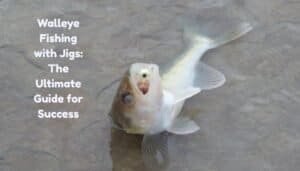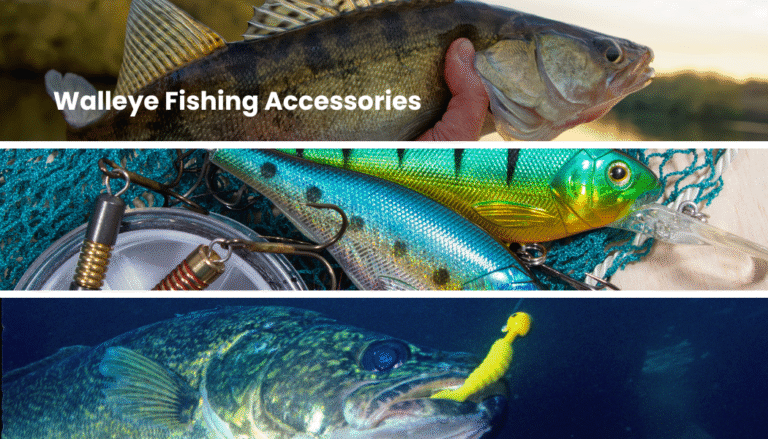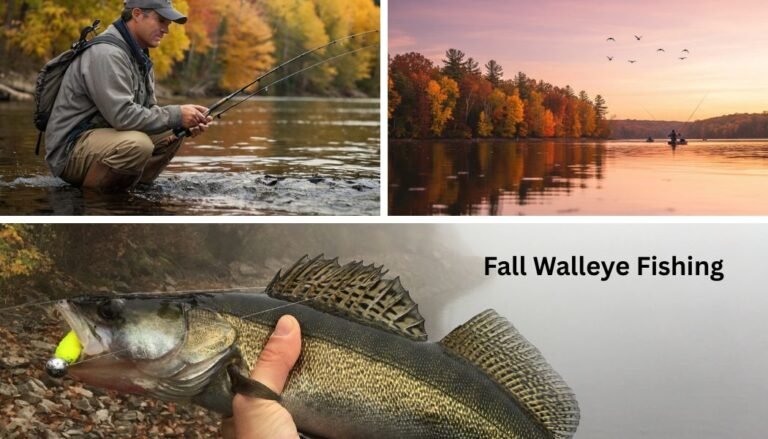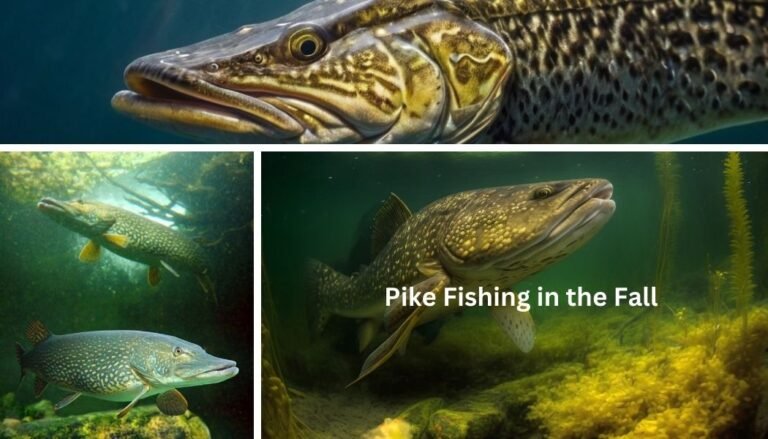Unlocking the Secrets of Jigging for Walleye Success
Are you ready to elevate your walleye fishing game? Walleye fishing with jigs is one of the most versatile and effective techniques, yet many anglers only scratch the surface of its potential. In this guide, I’ll take you through the nuances of jig fishing, from common setups to rarely discussed jig types that could be your secret weapon. Whether you’re a novice or a seasoned pro, this guide will help you outsmart those finicky walleyes! Let’s dive in and uncover the hidden gems of jigging for walleye.
Why Jigging is the Go-To Technique for Walleye Fishing
The Unique Behavior of Walleye and Why Jigs Appeal to Them
Let’s talk walleye: these fish are sneaky, almost like they’ve got a master’s degree in elusiveness. Walleye are primarily feed near the bottom, but they aren’t lazy – they’re strategic. Their eyes, which are super sensitive to light, give them an edge in dim conditions, and they love hanging out in murky water or just above the lakebed, where shadows and sediment obscure their movements.
That’s where jigs come in as the ultimate bait. Jigs mimic exactly what walleye are after – small, darting prey like minnows or leeches. When you bounce a jig off the bottom, it creates just enough action to catch their attention without scaring them off. I remember the first time I watched a walleye dart toward my jig. I swear my heart skipped a beat. The subtle tap of their bite is so faint, I almost missed it. But once I set the hook, the game was on!
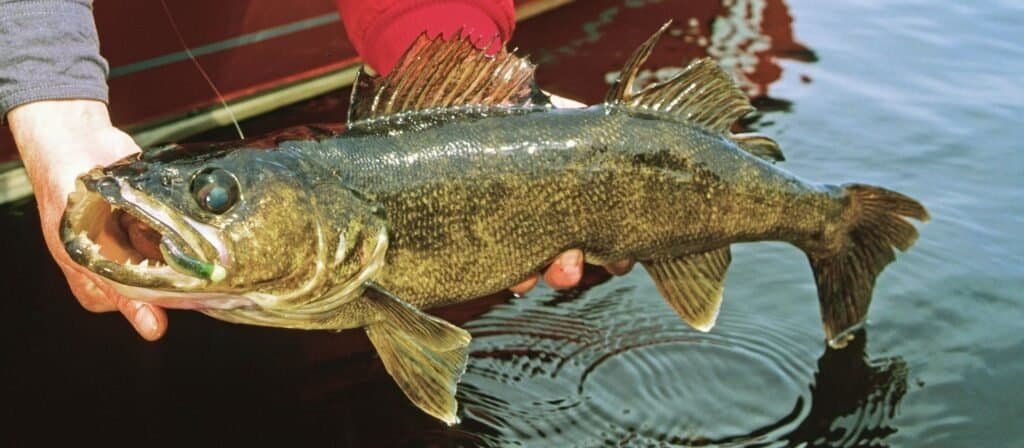
Benefits of Jigging: Precision, Adaptability, and Depth Control
Jigging isn’t just about dropping a lure and hoping for the best. It’s an art form, and once you get the hang of it, it feels almost meditative. One of the best things about jigging is how precise you can get. You’re in full control – adjusting the depth, speed, and movement of the jig to match what the walleye seem to want that day.
Adaptability is another big win here. Whether you’re fishing in 5 feet of water or 50, jigging works. You can easily swap out heavier or lighter jigs based on the depth or current. Plus, you can experiment with different colors, which, trust me, can make a huge difference. I’ve had days when a bright chartreuse jig was unbeatable and others when only a natural, darker shade worked.
Another perk is depth control. Since walleye often hang out just above the bottom, jigging allows you to stay right in their strike zone. The ability to keep your bait hovering in that sweet spot, just inches off the lakebed, makes it much more effective than some other techniques.
Success Stories from Experienced Anglers
There’s this one guy in my fishing circle, Jim, who’s practically a walleye whisperer. He swears by vertical jigging in early spring. He told me about a time he was fishing a narrow channel at sunset, slowly bouncing a ¼ oz. jig tipped with a shiner minnow. Jim pulled in over 20 walleye that evening, and he wasn’t even moving his boat. It was like every fish in the area had RSVP’d to his bait.
For me, the “aha” moment came during a chilly fall morning. I was using a feathered jig tipped with a leech. My buddy and I were barely talking because we were so focused on watching the rod tips. I felt that light, almost imperceptible tap; I set the hook and ended up reeling in my personal best, a fat, 27 inch walleye. The excitement was so contagious, even the guy fishing 20 feet away cheered for me.
Jigging isn’t just a technique; it’s a relationship you build with the water, the bait, and, ultimately, the fish. If you haven’t tried it yet, you’re missing out on a fishing method that’s as thrilling as it is effective.
Understanding Jig Types for Walleye Fishing
Classic Ball-Head Jigs: When and How to Use Them
Ah, the good old ball-head jig. If jigging had a Hall of Fame, this would be its first inductee. Simple, versatile, and highly effective, the ball-head jig is like the Swiss Army knife of walleye fishing. Its design – just a round head attached to a hook – might not seem fancy, but don’t let its simplicity fool you.
Ball-head jigs are my go-to when I’m fishing rocky bottoms or areas with minimal snags. Pair one with a soft plastic like a paddle tail or a live bait like a minnow, and you’ve got yourself a walleye magnet. I usually stick with 1/8 oz. to 3/8 oz., depending on the depth and current. One trick I’ve learned? Add a little twitch to your retrieve. That subtle movement mimics an injured baitfish, which is irresistible to walleye.
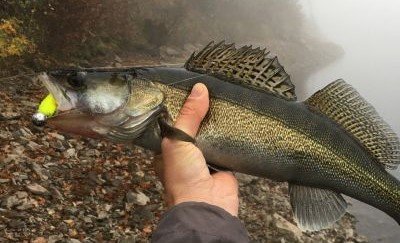
Finesse Jigs: Targeting Wary Walleyes
Walleye can get real finicky, especially during high-pressure days or when the water’s ultra-clear. That’s when finesse jigs shine. These jigs are smaller, lighter, and often feature subtle designs that don’t spook wary fish.
I remember one summer morning fishing a clear lake where the walleye were so cautious, they’d swim up to inspect the bait but wouldn’t bite. I switched to a 1/16 oz. finesse jig tipped with half a crawler and boom – it was like flipping a switch. The slow, delicate presentation was just what they needed. If you’ve got the patience to work a finesse jig, it can turn a slow day into a memorable one.
Hair Jigs: A Forgotten Classic Making a Comeback
Hair jigs might sound old school, but trust me – they’re making a serious comeback. These jigs use natural or synthetic fibers to create a lifelike profile in the water, and they’re deadly effective, especially in cold water.
I first tried a black bucktail hair jig on a chilly November day when live bait wasn’t cutting it. The soft, flowing motion of the fibers in the water was mesmerizing, not just for me but apparently for the walleye, too. They were hitting it hard, and I didn’t have to tip it with bait! If you haven’t added hair jigs to your tackle box yet, you’re missing out on a proven classic.
Blade Jigs: Combining Flash with Finesse
Blade jigs are the flashy cousins of traditional jigs, featuring a small metal blade that adds vibration and sparkle. These jigs are fantastic for stained water or when walleye are actively feeding.
I learned about blade jigs during a fishing trip on a windy day when visibility in the water was poor. A silver blade jig, tipped with a minnow, worked wonders, creating just enough flash and vibration to grab the walleye’s attention. The key is to balance the retrieve – too fast, and it can look unnatural.
Ice Fishing Jigs: Adapting the Technique for Hardwater
Walleye, don’t hibernate in the winter, and neither should your jigging skills. Ice fishing jigs, often smaller and heavier, are designed to drop quickly through the water column and hold steady in currents beneath the ice.
My go-to ice jig is a glow-in-the-dark tungsten jig tipped with a minnow head. Glow jigs are game-changers in the low-light conditions beneath the ice. One time, during a January trip, I caught five walleye in under an hour using a vertical jigging motion with slow pauses. It’s amazing how effective a little experimentation can be when you’re out on the ice.
Mastering these jig types opens up a world of possibilities for targeting walleye in any season or condition. Each one has its time and place, and knowing when to use them can make all the difference in your fishing success.
Advanced Jigging Techniques to Maximize Success
Vertical Jigging: Perfecting Your Presentation
Vertical jigging is where precision meets patience. It’s all about presenting the jig directly in the strike zone, and trust me, this technique can be a game-changer. The key to nailing vertical jigging is maintaining a straight line down to your bait – no slack. A good fish finder can help you locate where walleye are hanging out, but the real magic happens in how you work the jig.
Here’s a tip I learned the hard way: less is more. Early on, I’d overdo it, bouncing the jig too aggressively. Then, one day, a more experienced angler told me to slow down – just a small lift and a pause. That subtle motion mimics a baitfish hovering near the bottom, and the walleye couldn’t resist. Now, I always watch for the telltale “tap” that signals a bite. It’s faint, but once you feel it, set the hook quickly!
Dragging Jigs Along the Bottom for Subtle Attraction
Dragging jigs is the ultimate “lazy” technique, but it’s wildly effective when done right. This method involves letting the jig bounce and crawl along the lakebed, stirring up a little sediment cloud. Walleye love this because it looks like a scurrying crayfish or baitfish digging for food.
The trick here is using the right weight for your jig. Too light, and it won’t stay in contact with the bottom; too heavy, and it’ll get snagged constantly. I usually go with a ¼ oz. to ½ oz. jig, depending on the current. One memorable outing had me fishing a sandy flat, slowly dragging a jig tipped with a leech. It was almost boring until I hooked into a 5-pound walleye that fought like a freight train. Sometimes, simple wins the day.
Snap Jigging for Aggressive Strikes
If you’re looking to trigger a reaction bite, snap jigging is your best friend. This technique involves snapping the jig upward with a quick jerk and letting it fall naturally. The sudden darting motion followed by a slow descent mimics an injured baitfish, and walleye often can’t resist lunging at it.
The first time I tried snap jigging, I thought I was doing it wrong because I wasn’t feeling any bites. But then, out of nowhere, a walleye smashed my jig on the fall. That’s when I realized how crucial it is to pay attention during the descent – that’s when most strikes happen. A heavier jig paired with a paddle-tail soft plastic works wonders for this method, especially in deeper water.
Jigging with Live Bait: Pairing Soft Plastics or Live Minnows
There’s something timeless about jigging with live bait. Whether you’re using minnows, leeches, or worms, live bait adds scent and natural movement that soft plastics just can’t replicate. That said, combining soft plastics with live bait can give you the best of both worlds.
One of my favorite combos is a chartreuse jig tipped with a live minnow. The plastic gives it extra bulk and action, while the minnow’s movement seals the deal. I’ve also had great luck using a curly-tail grub paired with a leech – perfect for slower presentations. The biggest thing I’ve learned is not to rush the process. Let the bait do the work, and don’t overwork your jigging motion.
These advanced jigging techniques take practice, but once you’ve mastered them, you’ll see a noticeable difference in your catch rate. Whether you’re bouncing jigs vertically, dragging them lazily along the bottom, or snapping them aggressively, each method brings its unique appeal to the walleye’s table. Experiment, pay attention to what works, and let the fish tell you what they want.
Seasonal Strategies for Jigging Walleye
Spring: Targeting Shallow Waters with Finesse Jigs
Spring is when walleye are hungry and looking for easy meals after spawning. They tend to move into shallow waters where the temperature warms up quickly, making it the perfect time to break out finesse jigs. These lighter jigs excel in calm, shallow environments and allow for a subtle presentation that’s hard for walleye to ignore.
One spring morning, I found myself working a weedy flat with a 1/8 oz. finesse jig tipped with a soft plastic worm. I kept the retrieve slow, giving little hops and pauses to mimic a struggling insect or baitfish. It wasn’t long before I felt the unmistakable tug of a walleye on the other end. Patience is key here – don’t rush your movements, and always cast near structure like rocks or submerged logs where walleye might be hiding.
Summer: Adapting to Deeper, Cooler Zones
As the summer heat kicks in, walleye head for cooler, deeper waters. This is where precision and the ability to read your fish finder become invaluable. Heavier jigs, like ½ oz. ball-head designs are ideal for reaching those depths while maintaining control.
One summer outing had me jigging along a steep drop-off at about 20 feet. Using a jig tipped with a minnow, I let it sink to the bottom and worked it with slow, vertical lifts. It was tough at first, adjusting to the deeper water, but the payoff came when I landed a 24-inch walleye that had been lurking just above the thermocline. If you’re struggling, try experimenting with colors—bright options like chartreuse or orange often stand out in deeper, murkier water.

Fall: Aggressive Jigging to Trigger Feeding Frenzies
Fall is walleye season at its finest. As the water cools, walleye go into a feeding frenzy, stocking up before winter. This is the time to go big and bold with your jigging techniques. Snap jigging with larger blade jigs or hair jigs can provoke aggressive strikes that you might miss in other seasons.
Last fall, I was on a windy point, casting a blade jig in a shad pattern. Every few casts, I’d feel a heavy thud as a walleye hit my lure on the fall. They were so aggressive that day, even slight variations in the retrieve were enough to keep them biting. Fall jigging is about speed and reaction – don’t be afraid to experiment with quicker motions to ignite their predatory instincts.
Winter: Ice Fishing Jigs for Year-Round Action
When the lakes freeze over, walleye fishing doesn’t stop – it just shifts to ice fishing. Ice jigs, like tungsten teardrop styles or spoons, are designed for vertical presentations in small, confined areas. The challenge is keeping the bait enticing in such cold, slow-moving conditions.
One winter, I tried a glow-in-the-dark jig tipped with a wax worm during an evening ice fishing session. I gently lifted and dropped the jig, keeping an eye on my flasher to spot fish activity. After what felt like hours of waiting, a solid walleye finally took the bait. The glow feature seemed to make all the difference under the dim light. Lesson learned: Always bring a mix of jigs, and don’t underestimate the power of glow-in-the-dark in winter.
Jigging for walleye requires seasonal adjustments, but that’s part of the fun! Understanding their seasonal behavior; shallow in spring, deep in summer, frenzied in fall, and slow-moving in winter, gives you the upper hand. Embrace the challenge, and you’ll be rewarded with more memorable catches year-round.
Essential Equipment for Jigging Walleye
Rod and Reel Recommendations: Sensitivity and Power
When jigging for walleye, having the right rod and reel combo can make or break your success. Walleye are notorious for their subtle bites, so sensitivity is non-negotiable. A medium-light to medium spinning rod with a fast action is ideal. I personally swear by a 6’6″ rod paired with a smooth-spinning reel. The rod length offers precision, while the fast action helps me detect even the faintest nibbles.
One time, I was using a less sensitive rod, and I missed several bites that I didn’t even feel until it was too late. Lesson learned: spend a little extra for quality. Look for rods made from graphite, as they’re lightweight and transmit vibrations effectively. Pair it with a reel that has a smooth drag system to handle sudden runs when walleye decides to fight back.
Line Selection: Monofilament, Fluorocarbon, or Braided?
Choosing the right fishing line for jigging is like picking the right tool for a job—it depends on the conditions. Monofilament is a classic choice because it has some stretch, which can prevent hooks from ripping out during a fight. However, its sensitivity is lower, which can be a drawback when jigging.
For me, fluorocarbon is the sweet spot. It’s nearly invisible underwater and has great sensitivity, which is perfect for finesse presentations. Braided line, on the other hand, is unbeatable for strength and zero stretch, making it my go-to when fishing in deeper waters or heavy currents. I usually pair braid with a fluorocarbon leader to combine stealth with strength.
Jig Weight and Color Selection for Varying Conditions
Jig weight and color are more important than most anglers realize. The weight determines how quickly the jig sinks and how well you can maintain bottom contact in different water depths or currents. For shallow waters, I stick to 1/8 or 1/4 oz. jigs, while deeper zones call for 3/8 or even 1/2 oz. jigs.
As for color, it’s all about water clarity and light conditions. Bright colors like chartreuse and pink work wonders in murky water, while natural shades like brown and green excel in clear conditions. I’ll never forget one trip where I stubbornly stuck to a bright color in crystal-clear water and got skunked. Switching to a subtle green jig turned the day around completely.
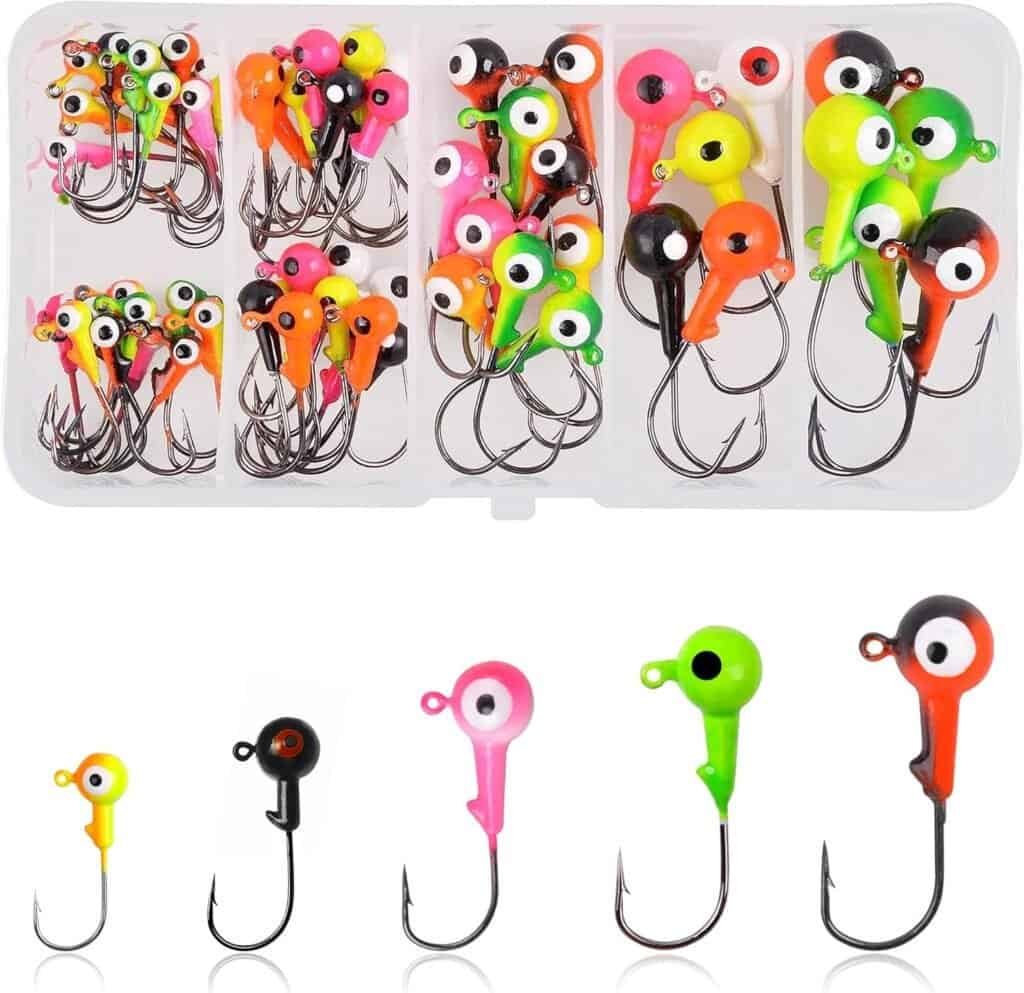
Accessories: Drift Socks, Sonar Devices, and Netting Tools
If you’re serious about jigging for walleye, investing in a few key accessories is a game-changer. Drift socks are fantastic for maintaining control in windy conditions or strong currents. They slow down your drift, allowing you to work your jig with precision.
A sonar device (fish finder) is like having X-ray vision for fishing. It helps you locate structure, find schools of walleye, and determine the best depth to fish. I can’t count the number of times my sonar showed fish at 20 feet when I would’ve guessed they were much deeper.
And let’s not forget a reliable net. Walleye are slippery and feisty, so having a rubberized net ensures you don’t lose your catch right at the boat.
Pro tip: Always keep the net within arm’s reach – I’ve learned this the hard way after fumbling around at the worst moments!
Final Gear Checklist
When you’re fully equipped with a sensitive rod, the right line, well-chosen jigs, and handy accessories like a sonar device and drift sock, you’re setting yourself up for jigging success. Remember, quality gear doesn’t just improve your chances of catching walleye – it makes the whole experience more enjoyable and less frustrating.
Pro Tips for Jigging Walleye Like a Veteran
Matching Jig Size to Water Conditions
One of the golden rules of jigging for walleye is matching your jig size to the water conditions. It’s not just about tossing a jig and hoping for the best. The size of your jig affects how it moves, how it sinks, and whether it can hold bottom in varying currents. For calm waters, lighter jigs – like 1/8 or 1/4 oz. – are perfect because they allow for a slower fall, which walleyes love.
In faster currents or deeper water, heavier jigs are essential. I learned this during a river trip where my lightweight jig kept drifting off target, and I couldn’t feel the bottom. Switching to a 3/8 oz. jig made all the difference. Always pay attention to how your jig behaves – if you’re not staying in contact with the bottom, it’s time to size up.
Using Sonar to Locate Fish and Structure
Using sonar effectively is a skill that separates weekend anglers from seasoned pros. The first step is to understand what you’re looking at – walleyes often appear as arches or blobs near the bottom. But it’s not just about spotting fish; sonar helps you identify key structures like drop-offs, humps, and submerged weed lines where walleyes love to hang out.
I remember one particularly slow day when I couldn’t locate fish using my usual techniques. A quick scan with my sonar revealed a rocky point at about 15 feet, loaded with fish. A few casts later, I was hooked into one of the biggest walleyes of my life. Use your sonar to fine-tune your jigging locations, and you’ll save hours of guesswork.
Adjusting Cadence to Trigger Bites
Cadence, the rhythm of your jigging, is often the secret sauce to catching walleye. Sometimes, a slow, steady lift and drop is all you need. Other times, a more aggressive snap jigging technique gets them fired up. The key is to experiment until you figure out what the fish want that day.
On one trip, I was dragging jigs along the bottom with no success. Out of frustration, I started giving my rod sharp upward snaps, letting the jig fall naturally. Boom – fish on! The erratic movement triggered an immediate reaction. Always vary your cadence, especially if the fish are being finicky.
Experimenting with Jig Color Combinations
Color matters more than you might think, but there’s no one-size-fits-all answer. What works in one lake might fail in another. Bright colors like chartreuse, or orange are my go-tos for stained water, while natural colors like green, pumpkin, or brown are killers in clear water.
One trick I’ve learned is to combine colors. For example, pairing a chartreuse head with a white soft plastic can create a high-contrast presentation that stands out in murky water. I once watched a buddy outfish me all morning until I noticed he was using a two-tone jig. I swapped mine out, and suddenly, it was game on.
Final Pro Tip
Remember, walleye fishing is as much about reading the conditions as it is about using the right gear or techniques. Match your jig size to the current, use sonar to locate prime spots, adjust your cadence to match the fish’s mood, and don’t be afraid to play around with color combinations. Success often comes down to the little details, so stay flexible and observant out there.
Common Mistakes in Jigging and How to Avoid Them
Over-Jigging or Excessive Movement
One of the most common mistakes, especially for beginners, is over-jigging. It’s tempting to constantly move your rod, thinking more action equals more bites. Trust me, I’ve been there – my first few outings, I looked like I was trying to dance with my rod. But walleyes prefer a more subtle presentation. They’re cautious predators, and overly aggressive jigging can spook them.
To avoid this, think about finesse. A gentle lift and controlled drop often outperforms wild, erratic movements. Pay attention to how the fish respond. If you’re not getting bites, don’t assume you need more movement – sometimes, less is more.
Ignoring the Importance of Depth and Speed
Depth and speed are everything in walleye fishing. I’ll admit, I spent too many trips jigging blindly, assuming the fish were at a certain depth just because they were last time. Big mistake. Walleyes are always on the move, and their preferred depth can change throughout the day.
Use your sonar to pinpoint the depth they’re holding at, and adjust your jig weight to maintain contact with the bottom. Speed matters too – if you’re drifting too fast, you’ll blow right past them. I learned the value of a drift sock after struggling on a windy day when my boat was moving too quickly. Slowing down allowed me to keep my jig in the strike zone longer.
Using the Wrong Jig for the Conditions
Not all jigs are created equal, and using the wrong one can mean the difference between a great day and going home empty-handed. For example, using a lightweight jig in deep water or fast current is practically asking for failure – it won’t sink fast enough, and you’ll lose contact with the bottom.
I once stubbornly stuck with a 1/8 oz. jig in a choppy river, thinking I could make it work. Spoiler alert: I didn’t catch a thing until I switched to a heavier 1/2 oz. jig. Match your jig weight and style to the conditions – heavier for deeper or faster water and lighter for calm, shallow areas.
Overlooking Seasonal Changes
Walleyes don’t behave the same way year-round, and your jigging strategy needs to reflect that. In the spring, they’re often in shallow, warmer waters, so finesse jigs work wonders. Come summer, they head deeper, and heavier jigs are the ticket. Fall calls for aggressive tactics to trigger their feeding instincts, while winter jigging requires small, precise presentations under the ice.
I ignored this seasonal behavior for years, wondering why my go-to techniques stopped working at certain times. A little research and some trial and error helped me fine-tune my approach. Keep the seasons in mind, and adapt your jigs and tactics accordingly.
Mistakes are part of the learning curve, but they’re also opportunities to get better. Avoid over-jigging, pay attention to depth and speed, match your jig to the conditions, and never overlook seasonal changes. It’s all about reading the water, the fish, and the conditions. The more you adjust, the more you’ll land those elusive walleyes!
Your Walleye Jigging Journey Awaits
Mastering the art of jigging for walleye requires a blend of technique, understanding, and experimentation. From choosing the right jig type to adapting to seasonal patterns, there’s always room to refine your skills. Now it’s your turn—gear up, head to your favorite fishing spot, and put these insights into action. With these tips, you’re well on your way to becoming a walleye jigging expert. Tight lines and happy fishing!
FAQ Section:
What is the best jig type for walleye fishing?
The best jig type depends on the conditions and season. Ball-head jigs are versatile and ideal for most scenarios, while hair jigs work well in cold water. For aggressive strikes, try blade jigs, and for finesse situations, opt for lighter jigs with soft plastics or live bait.
How do I choose the right jig weight?
Jig weight should match the water depth and current speed. For shallow waters or calm conditions, lighter jigs (1/8 to 1/4 ounce) work well. In deeper or faster waters, use heavier jigs (1/2 ounce or more) to maintain contact with the bottom.
What’s the best rod and reel setup for jigging walleye?
A medium-light to medium rod with a fast action tip is ideal for sensitivity and hooksets. Pair it with a spinning reel spooled with braided line for better feel and fluorocarbon leader for invisibility. This setup offers excellent control and responsiveness.
What colors work best for walleye jigs?
Color preferences can vary by water clarity and light conditions. In clear water, natural colors like white, green, and brown are effective. In murky water, use bright colors like chartreuse, pink, or orange to enhance visibility.
What common mistakes should I avoid when jigging for walleye?
Avoid overworking the jig with excessive motion sometimes, subtle movements work better. Ensure you’re fishing at the right depth for walleye, and adapt your jig type and weight to match conditions. Lastly, don’t ignore seasonal patterns, as they greatly influence walleye behavior.
Disclaimer: This blog post contains affiliate links

